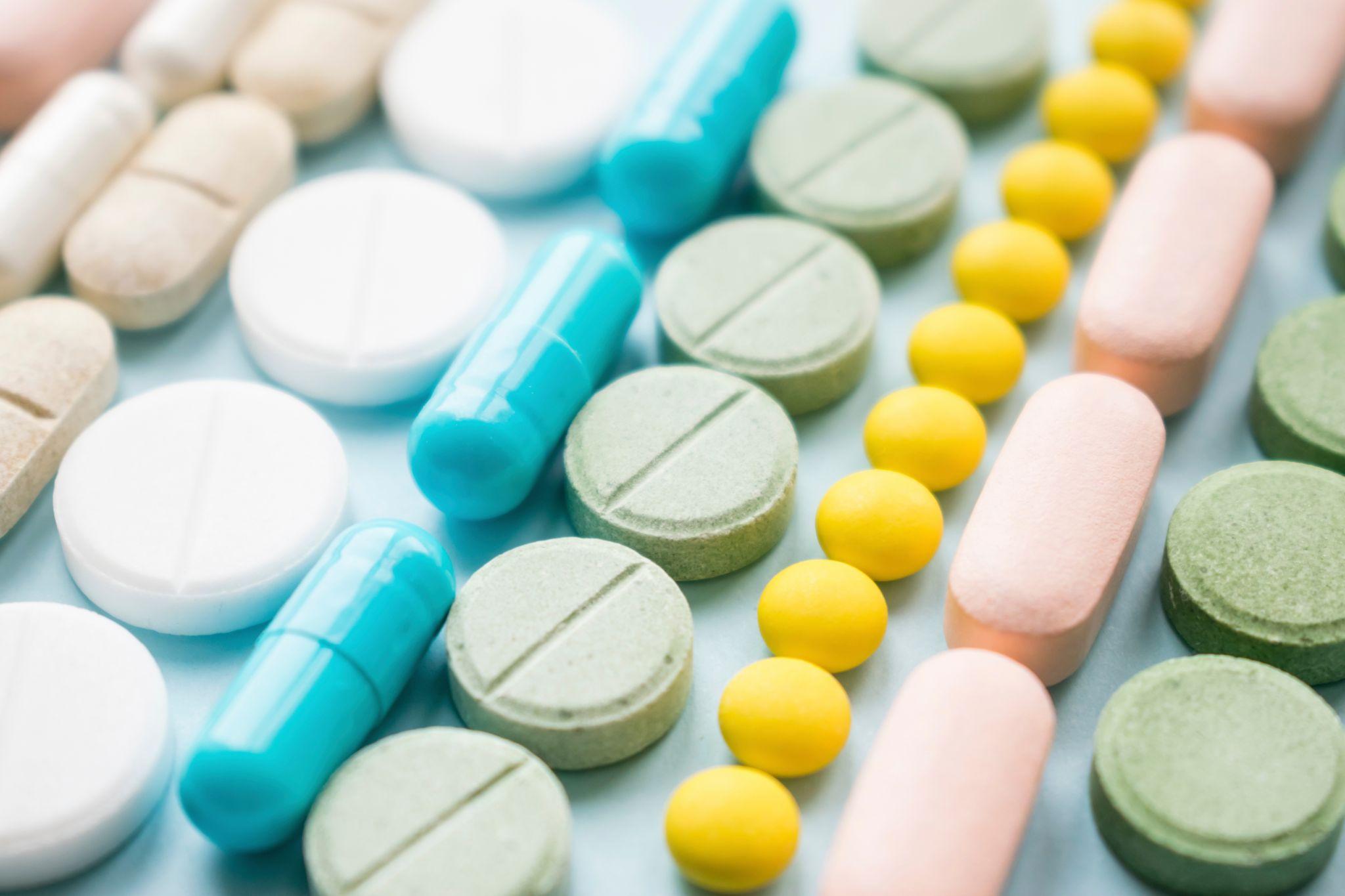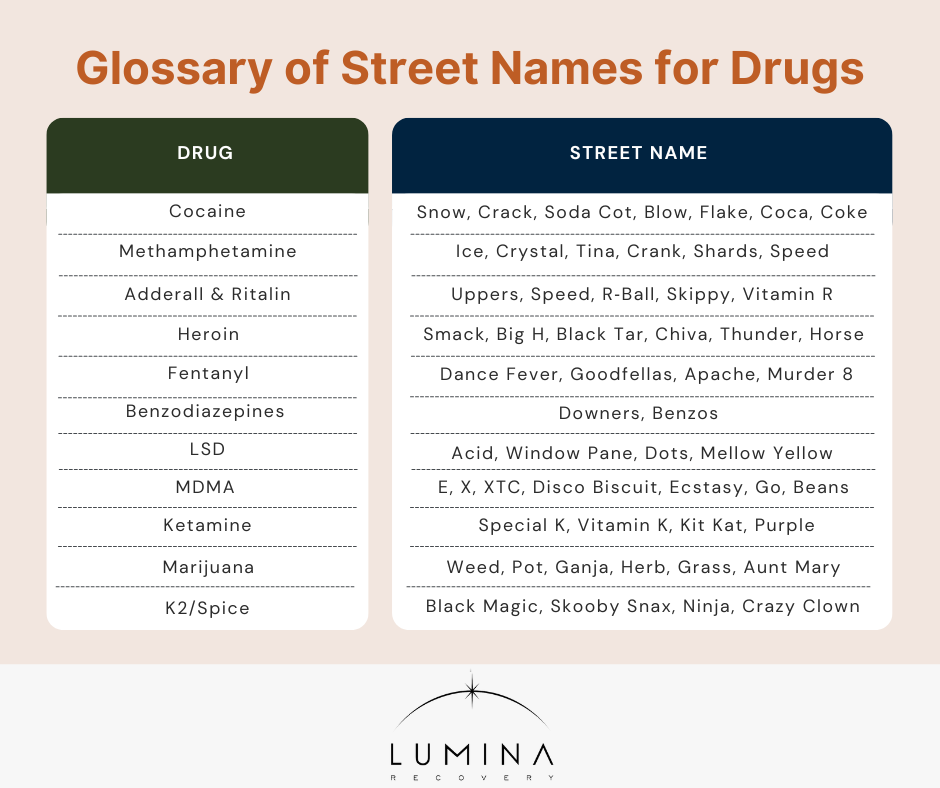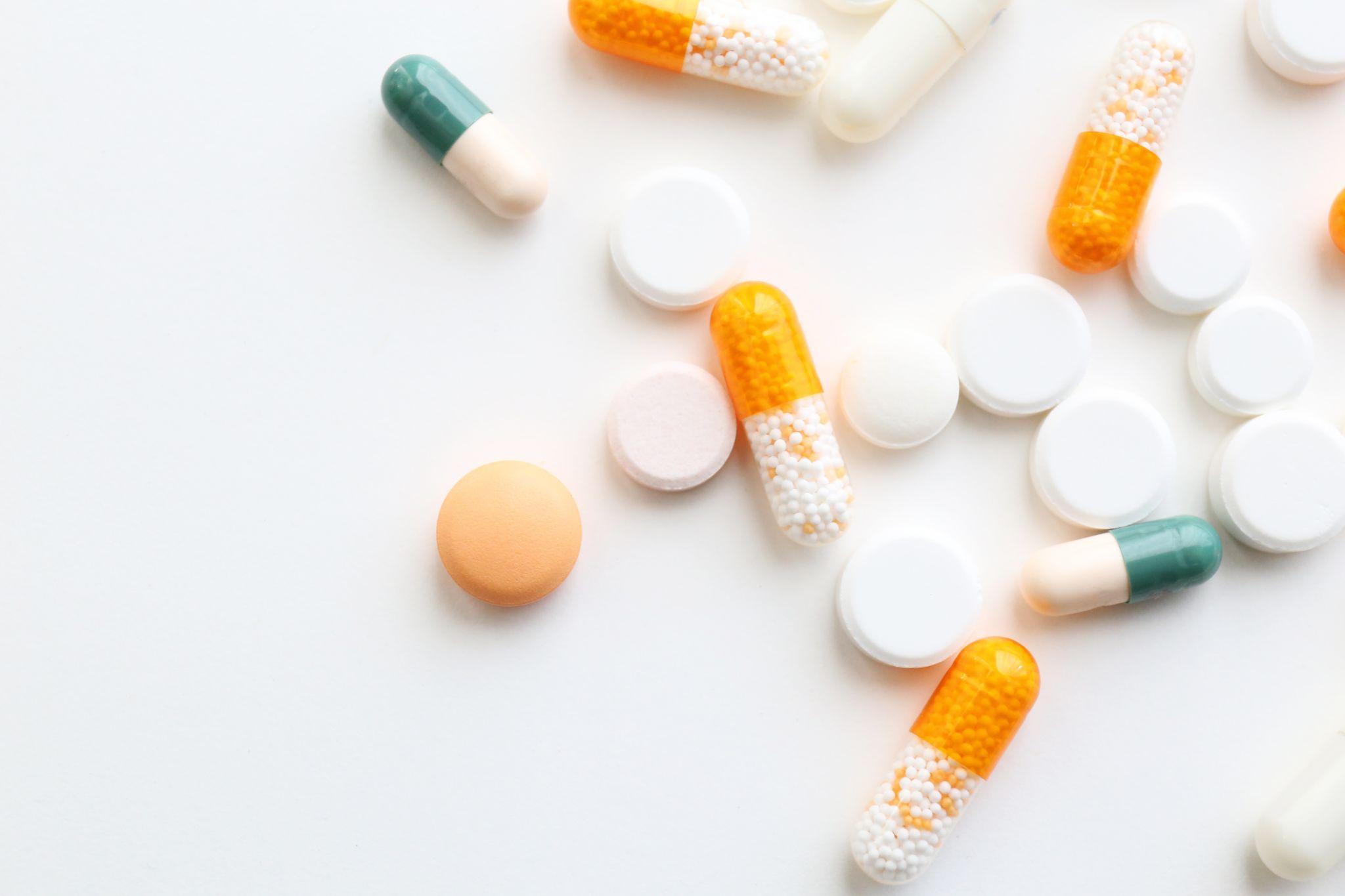The world of drugs is evolving every day, making it more important than ever to understand drug names, street names for drugs, and drug slang. These coded terms often mask the reality of substance use in our communities.
Our comprehensive list of slang words and common drug nicknames is designed to break down these barriers and empower you with essential knowledge to identify potential drug use.
At Lumina Recovery, we are committed to equipping individuals with the terminology and insights needed in our collective fight against addiction.
Why Street Names for Drugs Change Over Time
The evolution of drug names on the street is influenced by several factors:
- Pop culture and media. Movies, music, and social media not only entertain but also introduce new slang for drugs. These cultural shifts often inspire new drug street names that catch on quickly.
- Law enforcement pressures. As authorities become familiar with existing slang terms for drugs, users often develop fresh terms to stay one step ahead.
- Regional variations. Different areas may have their own unique drug lingo. The names of drugs on the street can vary widely, reflecting local customs and dialects.
- Social media influence. Social media has revolutionized how drug slang spreads online. Trends around social media and drug use continuously shape new street names for drugs and challenge efforts to monitor and address these evolving patterns.
These factors collectively contribute to why there are so many other words for drugs and why the list of slang words is constantly expanding.
List of Street Names by Drug Category
Below is a detailed breakdown of slang for drugs categorized by substance type. This section not only provides cocaine street names and street names for heroin (injected and smoked) but also highlights common drug names that have become part of everyday language.
Stimulants
- Cocaine: Snow, Crack, Soda Cot, Blow, Flake, Coca, Coke
Cocaine can increase heart rate and blood pressure, and long-term use may lead to severe cardiovascular issues. The slang for cocaine is part of a broader set of drug street names used to disguise the substance.
- Methamphetamine: Ice, Crystal, Tina, Crank, Shards, Speed
Methamphetamine is highly addictive. Its potent effects can lead to significant mental and physical health issues, making it one of the most dangerous of the names of drugs circulating today.
- Adderall and Ritalin: Uppers, Speed, R‑Ball, Skippy, Vitamin R
When misused, these stimulant prescription medications, such as Adderall and Ritalin, can cause heart problems and anxiety. They are another example of different words for drugs that might be used casually but have serious implications.
Depressants and Opioids
- Heroin: Smack, Big H, Black Tar, Chiva, Thunder, Horse
Heroin depresses the central nervous system, leading to slowed breathing and a high risk of overdose. These heroin street names are part of the broader drug slang that can mask the substance’s dangers.
- Fentanyl: Dance Fever, Goodfellas, Apache, Murder 8, Tango & Cash
Fentanyl is extremely potent, and its misuse has contributed to a significant number of overdoses. These fentanyl street names are crucial for understanding the threat posed by this drug.
- Benzodiazepines: Downers, Benzos
Often prescribed for anxiety, prescription drugs like Xanax and Valium when misused can cause sedation and respiratory issues.
Hallucinogens and Club Drugs
- LSD: Acid, Window Pane, Dots, Mellow Yellow
LSD significantly alters perception and can lead to dangerous behavior during a trip. Recognizing these drug street names is key to understanding their potential risks.
- MDMA: E, X, XTC, Disco Biscuit, Ecstasy, Go, Beans
MDMA can induce intense euphoria and empathy but also poses risks like dehydration and overheating.
- Ketamine: Special K, Vitamin K, Kit Kat, Purple, Cat Tranquilizer
While useful medically as an anesthetic, recreational use can lead to dissociation and memory issues.
Cannabis and Synthetic Drugs
- Marijuana: Weed, Pot, Ganja, Herb, Grass, Aunt Mary
Marijuana affects cognitive function and coordination. The names of drugs associated with cannabis reflect its longstanding presence in pop culture.
- K2/Spice: Black Magic, Skooby Snax, Ninja, Crazy Clown
Unregulated and potentially dangerous, synthetic marijuana can lead to unpredictable and severe health problems.
This list of slang words and drug street names provides a useful reference for anyone looking to understand the slang terms for drugs that are commonly used today.
New and Emerging Street Names
Drug slang continues to evolve. Staying informed about emerging drug trends and names of drugs on the street is crucial:
- Pink Cocaine: Tusi, Tuci, Tucibi
Emerging as a popular party drug, this term is becoming part of the modern drug lingo.
- Xylazine: Tranq, Tranq Dope
The drug is known as “tranq,” but when mixed with opioids like heroin or fentanyl, xylazine is referred to as “tranq dope.” Its rising use underscores the lethal nature of some drug names.
Knowing these new drug street names ensures you remain knowledgeable about the latest slang for drugs and the evolving common drug nicknames.
FAQs
Why do drugs have street names?
Drug users and dealers create slang for drugs to avoid detection by law enforcement. These drug street names evolve with pop culture, regional influences, and social media trends, leading to a rich variety of other words for drugs.
What are the most common street names for cocaine?
There are several cocaine street names including Snow, Crack, Soda Cot, Blow, Flake, Coca, Coke, and other less common variants.
How can parents recognize drug slang in texts?
Parents should be alert to drug slang used in messaging. Look for names of drugs like “Molly” (for MDMA), “Downer” (for Xanax), or “Aunt Mary” (for marijuana). If unfamiliar drug names appear, a quick search of these slang terms for drugs can clarify their meaning.
What is Tranq Dope, and why is it dangerous?
Tranq Dope is a mixture of opioids like fentanyl with xylazine. This potent combination is especially dangerous because xylazine is not an opioid, making it harder to treat an overdose.
What are the common drug street names?
Common drug street names include:
- Cocaine: Blow, Snow, Coke
- Methamphetamine: Ice, Crystal, Tina
- Heroin: Smack, Big H, Black Tar
- MDMA: Ecstasy, Molly, E, XTC
- Marijuana: Weed, Pot, Ganja
- Fentanyl: Apache, Dance Fever, Murder 8
Understanding these common drug nicknames and names of drugs helps in recognizing and addressing hidden substance use.
Get Help for Drug Abuse With Lumina Recovery
By familiarizing yourself with this expansive list of slang words, including drug slang and common drug nicknames, you’re better equipped to understand and identify the names of drugs on the street. Awareness of these slang terms for drugs is a vital step in addressing substance use and protecting vulnerable individuals.
At Lumina Recovery, our detox and residential inpatient programs are designed to support those struggling with many different types of addictions. Our comprehensive approach ensures that you receive the help you need to navigate the complex world of addiction.
If you’re concerned about a loved one or your own substance use, get in touch with our team of addiction experts today.




